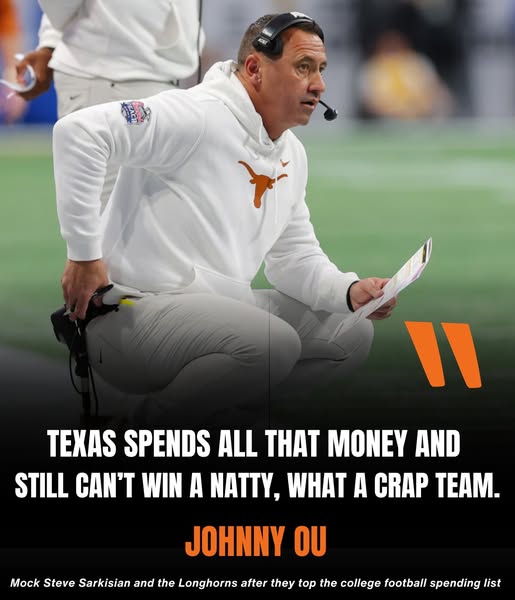“$40 Million and Nothing to Show for It: Analyst Blasts Steve Sarkisian as Texas Longhorns Struggle to Justify Historic Spending”
The Texas Longhorns entered this era with ambitions as big as the state they represent, sparing no expense in their quest to reclaim national glory. Steve Sarkisian was handed the keys to one of the most prestigious programs in college football, and the university put its money where its mouth was. Reports indicate that Texas has poured over $40 million into the football program since Sarkisian’s arrival, with a combination of his lucrative salary, staff upgrades, recruiting resources, and cutting-edge facilities. Yet, as another season looms on the horizon, critics and fans alike are asking the same uncomfortable question: where are the results?
Johnny Rogers, a prominent analyst known for pulling no punches, summed up the growing sentiment among fans in a biting remark that quickly made headlines: “Forty million dollars, and Texas still can’t buy a title.” That line has sparked debate across the college football world and cast an even brighter spotlight on Sarkisian, a coach who came to Austin with championship pedigree and a reputation as an offensive mastermind. While Sarkisian has managed to stabilize the program, the bar for Texas has always been higher than stability. The expectation isn’t merely to compete in the Big 12—it’s to dominate, to reach the College Football Playoff, and to bring a national championship back to Austin for the first time since 2005.
The investment Texas has made since hiring Sarkisian in 2021 is staggering. His contract alone is among the most lucrative in college football, reportedly paying him well over $10 million annually with extensions already in place. Beyond that, Texas revamped its entire infrastructure to give Sarkisian every advantage possible—state-of-the-art training facilities, top-tier support staff, and unprecedented recruiting budgets. NIL deals for players surged, fueled by Texas’ wealthy donor base eager to ensure the Longhorns could land elite talent. In theory, these moves were designed to eliminate any excuse for mediocrity. Texas wanted results, and it wanted them now.
But the path has been anything but straightforward. Sarkisian’s first season was a disaster by Texas standards, finishing with a losing record that included a stunning six-game losing streak. Fans who thought the dark days of underwhelming seasons were behind them were forced to question whether this was just another expensive experiment doomed to fail. Year two brought improvement and renewed optimism as Texas won eight games and showed flashes of what could be, highlighted by a near-upset of Alabama in Austin. Year three finally delivered a breakthrough as the Longhorns captured a Big 12 title and earned a spot in the College Football Playoff. Yet even that accomplishment was tempered by reality: Texas fell short of winning a national championship, and in Austin, that’s the only goal that matters.
Critics like Rogers argue that for the kind of money Texas has shelled out, incremental progress isn’t enough. “When you’re talking about a program that’s invested $40 million and counting, anything short of a title is failure,” he said during a recent segment. “They didn’t bring Sarkisian in to win a conference championship; they brought him in to restore Texas to the pinnacle of college football. Three years in, we’re still waiting.”
Supporters of Sarkisian push back against the harsh criticism, pointing to the undeniable strides the program has made under his leadership. Recruiting has never been stronger, with Texas consistently landing top-five classes loaded with five-star talent. The culture within the program has improved, and player development has shown tangible progress. Arch Manning, one of the most hyped recruits in college football history, chose Texas over a host of other blue-blood programs in large part because of Sarkisian’s vision for the future. These are not small feats in an era where competition for elite players is fiercer than ever.
The looming move to the SEC, however, adds another layer of urgency to the conversation. Texas will no longer have the luxury of dominating a weaker Big 12 schedule; the gauntlet of Alabama, Georgia, LSU, and other SEC heavyweights awaits. That means the margin for error shrinks significantly, and patience—already thin among the fan base—could evaporate entirely if the Longhorns stumble out of the gate in their new conference home. For all the talk about facilities and NIL money, games are still won on the field, and the SEC is where reputations are made or broken.
Financially, Texas has set a new standard for investment in college football, but history shows that money alone doesn’t guarantee championships. Programs like Texas A&M have also spent lavishly with mixed results, proving that the equation for success is far more complex than writing big checks. Coaching acumen, player execution, and a little bit of luck still play critical roles. Sarkisian has shown he can draw up brilliant game plans and recruit at an elite level, but the challenge now is turning those advantages into trophies.
Rogers’ criticism struck a nerve not only because of its bluntness but also because it echoes a fear many Texas fans quietly harbor: what if this doesn’t work? The program’s identity has been in flux since the glory days under Mack Brown. Multiple coaching hires—Charlie Strong, Tom Herman—failed to meet expectations despite strong résumés and significant financial backing. Sarkisian was supposed to be different, the offensive genius who could finally match Texas’ resources with on-field dominance. The thought of another expensive swing-and-miss is enough to keep boosters and administrators awake at night.
The pressure cooker in Austin is unlike anywhere else in college football, and Sarkisian knew that when he took the job. Every move is scrutinized, every loss magnified. Winning 10 games might be a reason to celebrate at most programs, but at Texas, it barely moves the needle if there’s no national championship attached. That relentless expectation is both a blessing and a curse—it fuels the program’s ambition but also makes it a volatile environment for any coach who falls short.
For now, Sarkisian remains confident and publicly unfazed by the noise. He’s emphasized that building a championship program is a process, one that requires time and consistency. Still, time is the one thing Texas doesn’t seem to have in abundance, at least in the eyes of its fans and critics. With the SEC transition looming and expectations soaring, the window for Sarkisian to deliver is narrowing.
As summer workouts give way to fall camp, the spotlight will burn brighter than ever. Every practice, every press conference, every game will be viewed through the lens of whether Texas is finally ready to reclaim its throne. Anything less than a playoff berth and a legitimate shot at a national title will only amplify the questions—and the criticism. For Sarkisian, the challenge is clear: justify the investment, silence the doubters, and bring Texas back to the promised land. If he succeeds, the $40 million price tag will look like a bargain. If he fails, Rogers’ mocking words will echo through the halls of Darrell K Royal–Texas Memorial Stadium for years to come.
Texas didn’t spend $40 million to be good. It spent $40 million to be great. Now it’s up to Sarkisian to prove that greatness is more than a slogan, that all the money, hype, and expectations can finally culminate in the one thing this program craves above all else: a national championship. Until then, the whispers of doubt will linger, and the critics will circle like vultures, waiting for any sign of weakness. Because in Austin, there are no moral victories, only titles—and $40 million buys no excuses.



